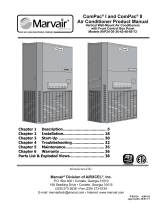Page is loading ...

ComPAC
Chiller unit with screw compressor
Installation guide EN

Installation guide - ComPAC
2/7 011829 en 2022.08
ComPAC Installation guide
ComPAC units
Please note that this installation guide only describes the main issues to con-
sider during installation.
Installation guidance is available in the operating manual, which must be read
carefully before operating the equipment.
Make sure to observe all local and national installation and safety
precautions.

Installation guide - ComPAC
011829 en 2022.08 3/7
ComPAC Installation guide
Lifting instructions
Lifting eyes are welded on the base frame of the ComPAC. They are clearly marked with red
paint. The ComPAC must be lifted in these lifting eyes only, see Fig. 1 and Fig. 2.
Note: Lifting eyes are mounted on the compressor unit but these lifting eyes must NOT be
used to lift the ComPAC chiller unit.
Always use lifting yokes when handling the chiller to avoid damaging pipes, valves, insulation
and other components. Check that the crane, lifting yokes and steel wire are approved lifting
devices and have the necessary strength to lift the ComPAC.
To avoid damaging the chiller unit, some of the steel wires must be angled while lifting the unit
as shown in Fig. 1 and Fig. 2.
The exact weight and centre of gravity of the ComPAC is shown in the GA drawing.
Fig. 1
Fig. 2

Installation guide - ComPAC
4/7 011829 en 2022.08
ComPAC Installation guide
Planning the machine room
When planning the machine room, it is important to make sure that there is enough space
around the plant to allow repairs and maintenance tasks to be carried out without problems.
Fig. 3 shows the minimum spacing in millimetre.
Fig. 3
A) For operation and opening of the electrical panel 1000 mm
B) For removal of the Vi slide 550 mm
C) For maintenance 600 mm
D) For operating Unisab III 600 mm
The foundation must have the necessary bearing strength and be as plane as possible.
D
C
B
A

Installation guide - ComPAC
011829 en 2022.08 5/7
ComPAC Installation guide
Vibration dampers
ComPACs are designed for either 4 or 6 vibration dampers. For installation on solid concrete
floor, anti-vibration machine feet are sufficient. Such machine feet are designed for minimum
70% vertical isolation (100% capacity).
For installation on decks, special dampers are often required. Please consult a vibration expert
or a Johnson Controls Denmark representative for further information.
To ensure optimum effect of each individual anti-vibration machine foot, the load on the feet
must result in roughly the same deflection of all machine feet, see Fig. 4. Deflection of a ma-
chine foot can be adjusted by increasing or reducing the load compared to the other supports
by turning the adjusting rod.
Fig. 4: Anti-vibration machine foot
Other damper types can be adjusted by using liner plates.
Lo a d e d s t a te
L o ck n u t
U n loa d e d s t a te

Installation guide - ComPAC
6/7 011829 en 2022.08
ComPAC Installation guide
Connection of pipes
Connect all piping and mount all hoses and valves for compressor cooling.
The piping design must include considerations regarding function, suspension, vibrations, ther-
mal expansion and pre-stress after welding in order to avoid high load on the unit connections.
The safety valves are fitted on the unit from factory. The pipe connection to the valve discharge
branch must be made in accordance with valid rules/standards. External piping and condens-
ers are not protected by the safety valves fitted on the unit.
Leak and pressure test
Leak and pressure test according to the applied/local codes and rules. Isolate the compressor
unit from the test pressure or disconnect pressure transducers and safety valves. Never ex-
ceed the test pressure of the unit stated on the unit name plate. All ComPAC units are pressure
and performance tested from factory.
Electrical connection
Connect power supply wiring according to electrical diagrams.
Final check
Check all relevant components, connections, electrical connections, safety valves, safety high
pressure cut-out and machine room safety.
Evacuation
Evacuate the system using a vacuum pump for 5 mm Hg and perform a vacuum test.
Note: The unit is pressurised with approximately 0.5 bar (g) nitrogen from factory. The nitrogen
will often be mixed with a minor amount of R717 vapour left from the factory test (absorbed in
oil). This should be taken into account when positioning the discharge from the vacuum pump.
Charge oil
Charge oil, if not charged from factory. The oil level should be visible in the middle of the upper
sight glass.
Note: ComPAC units can be charged with either S68 or PAO oils.

Installation guide - ComPAC
011829 en 2022.08 7/7
ComPAC Installation guide
Charge refrigerant
The P&I diagram states the charge for each specific chiller. Start out by charging 75% of the
specified R717 charge.
After start-up carefully charge more R717 until the suction superheat is between 0.5 and 3°K.
Check the liquid level in the evaporator. Droplets should come out of the top of the plates.
The plates should not be completely covered by liquid.
Note: The liquid level must never be visible in the inspection glass.
Power supply
Turn on power.
Control system
Check the UniSAB III control system settings including calibration according to the UniSAB III
manual.
Motor
Check the direction of rotation of the compressor motor.
Coupling
Check alignment of coupling.
ComPACs are equipped with flange motors, and alignment is normally notnecessary.

Johnson Controls Denmark ApS
Sabroe Factory
Christian X's Vej 201 ∙ 8270 Højbjerg
Denmark
Phone +45 87 36 70 00
www.sabroe.com
Version 2
/















